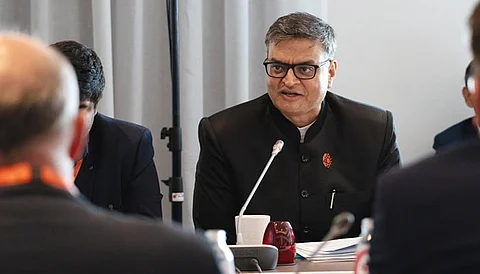

New Delhi: The International Solar Alliance (ISA) is focusing on integrated photovoltaics technology that helps buildings generate solar power and reduce emissions, its Director General Ashish Khanna said on Monday. He stressed on the need to embed solar intelligence into architecture itself. Addressing the 17th GRIHA Summit being held in the national capital, Khanna noted that urban areas consume over 70 percent of global electricity and produce more than two-thirds of emissions.
Follow Energy Watch on X
"This trend is likely to enhance further as the residential consumption of electricity is expected to have the highest share of increase in energy consumption over next few decade," he added. The two-day summit, starting Monday, has been organised by the GRIHA Council, which administers the green building rating system GRIHA.
Khanna pointed out that pollution in cities is already choking the lives of the next generation and impacting sustainable growth. "Yet, the vast potential of their roofs, façades, and skylights remains untapped," he rued.
"To decarbonise cities, we must go beyond adding renewables to the grid — we must embed solar intelligence into the architecture itself. This would require innovations across dimensions of institutions, technologies, and financing," Khanna said.
He urged the GRIHA Council to expand to other developing countries to promote building regulations, affordable certification, and the absorption of new climate-resilient technologies.
Talking about the potential of Building-Integrated Photovoltaics (BIPV) technology, Khanna said it can transform the skin of buildings into power-generating assets — merging energy, aesthetics, and function. "For the Global South, where land is limited and infrastructure is expanding rapidly, BIPV is not a luxury — it is a strategic necessity that allows growth without sprawl, energy access without emissions," he added.
The ISA considers BIPV as a pillar of the urban solar revolution and a gateway to climate-resilient infrastructure. "We recognise that climate resilience begins where people live and work — in homes, schools, hospitals, and offices," Khanna said.
Therefore, he explained, the ISA’s aim is to turn BIPV from a niche technology into a mainstream instrument of climate-resilient urban growth — one that connects the construction sector and the solar industry across public and private sector players.
Khanna shared that the ISA is preparing to launch at COP30 the Case Study Compendium – ‘BIPV in Action’, which demonstrates how technology, design, and policy can converge to solve region-specific climate challenges — from humid coastal regions to dust-prone deserts, from snow-laden mountains to tropical megacities.
He said BIPV can be customised for climate resilience, ensuring reliable solar generation even under the harshest conditions. The ISA is also developing a BIPV Guidebook — a practical blueprint covering design principles, certification standards, and policy integration strategies for its member countries.
"The world’s buildings will double in floor area by 2060. Every design decision taken today locks in either vulnerability or resilience for decades. If we act boldly now, these very buildings can become our first line of climate defence — energy-positive, thermally efficient, and materially circular," Khanna said.
Follow Energy Watch on LinkedIN
The ISA, a collaborative initiative between India and France, was conceptualised on the sidelines of COP21 in Paris in 2015 to unite global efforts in combating climate change through solar energy solutions.
